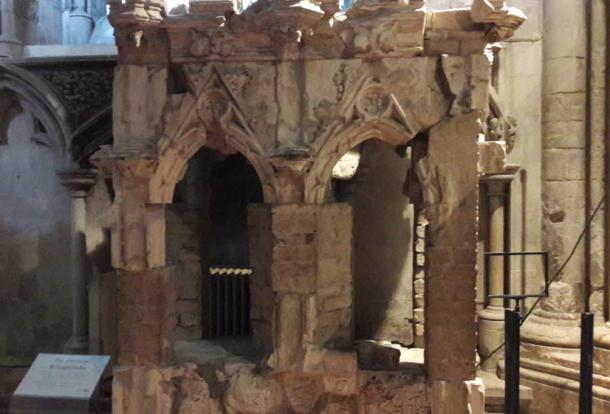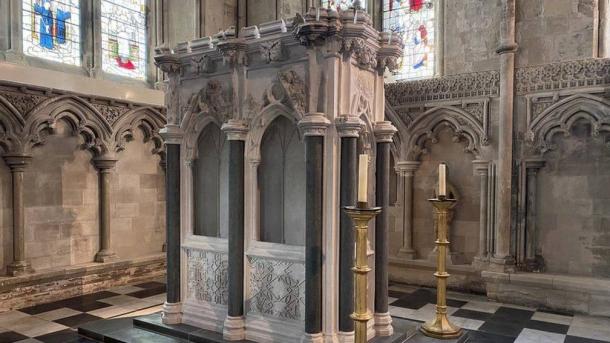
New Masked Carving in St Albans Cathedral Restoration is Distasteful
St Albans Cathedral in Hertfordshire is the oldest site of continuous Christian worship in Britain and work to restore its rare medieval shrine has just been completed. But the addition of a new carving wearing a face mask is both tacky and distasteful and is akin to the masked Santa and Easter Bunny merchandise and more that we’ve been plagued with since the start of the Covid-19 outbreak.
The St Albans Cathedral website announced that the medieval shrine of St Amphibalus, located near the shrine of St Alban, Britain’s first Saint, has been restored to its former glory. But clearly the addition of a masked man to the precious shrine has not been with historical likeness in mind.
“Amongst the range of carvings, visitors will be able to spot a modern addition of a man wearing a face-mask to commemorate the shrine’s restoration project taking place during the pandemic,” the Cathedral website reports.
While intentions may have been commemorative, the addition of a modern-day masked man on a medieval shrine – one of Britain's 13 medieval pedestal shrines – has politicized the restoration work, and for some, left a sour taste in the mouth.

The shrine of St Amphibalus prior to the restoration work. Pjposullivan1 / Flickr (CC by SA 2.0)
The Burial Site of a Martyr
St Albans Cathedral sits on the site where Alban was buried and made into a martyr after he was tortured and beheaded sometime during the 3rd or 4th century by Romans for sheltering a Christian priest, known as Amphibalus, at a time when Christians were facing heavy persecution.
It is believed that the cathedral was built on the site of his execution, and a well at the bottom of the hill, Holywell Hill, is said to be the place where Alban’s head landed after rolling downhill.
The shrine of Amphibalus was built to hold the remains of Amphibalus after they were brought back to St Albans in 1177 AD.
- Notre Dame De Paris: Survivor Of 850 Years Of Upheaval, Revolution, World Wars And Fire
- England’s Long Man Vandalized By Covid-19 Criminals
- French Brotherhood, Still Burying the Dead After 800 Years

St Albans Cathedral viewed from the west in Hertfordshire, England (CC by SA 3.0)
The restoration work on the shrine of St Amphibalus took more than a year to complete and numerous delays were caused along the way by the Covid-19 situation. With the exception of the face mask carving, the end result is exceptional and brings new life to the medieval shrine.
Dr David Carrington, director of Skillington Workshop, which carried out the work, said: "The preservation of the surviving 14th Century carvings, the setting-out to allow restoration of missing sections and the interpretation and carving of these missing bits in the original spirit and style all presented unique challenges" (via BBC).
The Reverend Canon Abi Thompson, Acting Dean of the cathedral, said that the newly restored shrine “creates a fresh focus for prayer, and is a beautiful way to tell part of the story of this extraordinary place to visitors”, who will have an opportunity to view the restored shrine when the cathedral reopens on May 17.

The newly-restored shrine of St Amphibalus in St Albans Cathedral. Credit: St Albans Cathedral
The Masked Menace
The Reverend Canon Abi Thompson has put a positive spin on the addition of the masked figure, saying: "The masked figure reminds us that the history of St Albans stretches forwards as well as backwards, and pilgrims will be able to mark the latest chapter in the history of this Cathedral alongside Amphibalus and Alban, who were there at the very beginning.” (via BBC).
However, the use of face coverings throughout the Covid-19 pandemic has been a contentious political issue, resulting in dozens of mass protests around the world, and therefore has no place on a sacred medieval shrine.
Similar stunts have taken place across the UK, including the defacement of the Long Man of Wilmington geoglyph, a giant chalk figure in East Sussex, with a tasteless Covid-19 facemask, as well as the defacement of the Cerne Abbas Giant chalk figure in Dorset to promote the new Borat film. In the latter case, a huge face mask was stretched over the figures genitals with the slogan “Wear mask. Save lives”.
The year 2020 will certainly go down in history as the year that Covid-19 began. But we don’t need to destroy, damage or deface historical monuments with face masks to remind us of this fact.
Top image: A figure wearing a face mask in St Albans Cathedral. Credit: St Albans Cathedral
















Comments
Get real, masons have always [rudely and funnily] commented on human behaviour, this is one such episode. They should have an anti-vaxer being pitchforked [pricked, oh the irony!] to death there too, that would be hilarious!
Well said! it’s utterly unbelievable
-KLM
Why anyone would think placing a mask on an ancient work of art is acceptable is beyond comprehension. At best this act of vandalism is another display of being entirely out of touch with reality...at worst it's another center stage performance, in a long line of ritualistic and beastly crimes that continue, unchequed, against the history of humanity. They know exactly what they're doing and why. Termed as ‘paranoid conspiracy theory’ or not~so do we. The ‘joke’ is clearly on those of us who still have a detectable pulse.